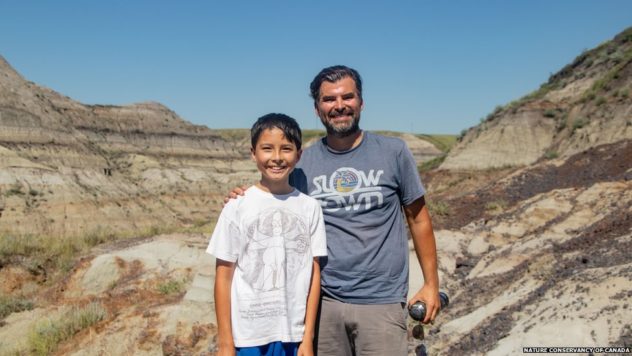© Nature Conservancy of Canada via CNN.com
Pre-reading questions:
I will read each question. Then, please answer them.
- What dinosaur species do you know?
- What images come to your mind when you hear the word dinosaur?
Vocabulary:
I will read the words, meanings, and sample sentences. Then, repeat after me.
- partly /PAHRT-lee/
- unearth /uhn-URTH/
- institute /IN-sti-toot/
- curator /kyoo-REY-ter/
- significant /sig-NIF-i-kuhnt/
[adverb] – to some degree, but not completely
What the boy said was partly right.
[verb] – to find something by digging in the ground
Ancient tools that are more than 500 years old have been unearthed at the site.
[noun] – an organization where people do a particular type of scientific, educational, or social work, or the buildings that it uses
She is working at an art institute.
[noun] – a person in charge of a museum, library, etc
The museum curator guided us around the museum.
[adjective] – important or noticeable
One of the best memories I have of him was when I first got him. It is a very significant moment in my life.
Article reading:
Please read the whole article. Then, I will check your pronunciation and intonation.
A 12 year old boy from Calgary named Nathan Hrushkin discovers a partly uncovered dinosaur fossil while on a hike with his father at Horseshoe Canyon’s conservation site in Alberta, Canada. Nathan found a humerus bone from the arm of a young “hadrosaur” — a plant-eating dinosaur with flattened jaws similar to a duck, that lived 69 million years ago. Nathan and his father, Dion, found the fossil uphill but were careful not to unearth it themselves. They sent the photos and GPS location to the Royal Tyrrell Museum of Paleontology, a research institute that studies fossils and ancient life. The institute then sent a team of researchers to the site where the bone was found.
The Nature Conservancy of Canada mentions not to disturb or dig up any fossils people may find since these are protected by law. So far, 30-50 bones have been found all coming from a single hadrosaur believed to be 3-4 years old. The Royal Tyrrell Museum’s curator of dinosaur palaeoecology François Therrien says that the discovery is significant to provide more information about dinosaurs that lived in Alberta and their evolution.
The Nature Conservancy of Canada mentions not to disturb or dig up any fossils people may find since these are protected by law. So far, 30-50 bones have been found all coming from a single hadrosaur believed to be 3-4 years old. The Royal Tyrrell Museum’s curator of dinosaur palaeoecology François Therrien says that the discovery is significant to provide more information about dinosaurs that lived in Alberta and their evolution.
Comprehension Questions:
I will read each question. Then, please answer them based on the article.
- Where did Nathan Hrushkin find the dinosaur fossil?
- What kind of dinosaur is a hadrosaur?
- According to the article, how many bones were found around the area?
- Did Nathan and Dion dig up the fossil themselves? Why or why not?
- What did the museum’s curator say about the discovery?
Discussion Questions:
I will read each question. Then, please answer them.
- In your opinion, why are fossils protected by law? Are they important?
- In your own opinion, what kind of father is Dion to Nathan?
- What do you think wiped out the dinosaurs?
- What do you think life was like for men and women when dinosaurs were around?
- What questions would you like to ask scientists about dinosaurs?
